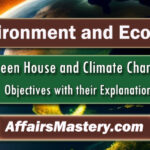Set 4 | Important Greenhouse Effect and Climate Change MCQs
Important Greenhouse Effect and Climate Change MCQs. Greenhouse Effect and Climate Change plays a crucial role within the broader field of environment and ecology. It serves as a foundational concept for achieving success in competitive exams such as Civil Services, State exams, SSC, Railways, Banking, and more. Mastering these subjects offers a unique advantage, allowing you to gain invaluable insights into the country’s environmental legacy. With a focus on Environment, Biodiversity, and Ecology, this knowledge not only sharpens your competitive edge but also equips you to excel in these challenging exams.
| MCQs on Greenhouse Effect and Climate Change – Objective Questions and Answers |

Q31. Global Warming is caused due to the emission of: (U.P.P.C.S. (Mains) 2004)
[A] Nitrogen
[B] Carbon Dioxide
[C] Carbon Mono-oxide
[D] Hydro Carbon
View Explanation
Correct Answer is B.
- Global warming is primarily caused by excessive carbon dioxide (CO₂) in the atmosphere. This carbon overload is mainly the result of burning fossil fuels such as coal, oil, and natural gas, as well as deforestation and forest fires. In 1950, atmospheric CO₂ levels were approximately 315 parts per million (PPM).
- Currently, they have exceeded 415 PPM. If the current rate of increase persists, CO₂ levels are projected to reach approximately 650–950 PPM by the end of the 21st century. This could potentially raise Earth’s temperature by 6°C , leading to severe climate impacts.
Q32. Which one of the following is the most fragile ecosystem that will be first affected by global warming? (Uttarakhand P.C.S. (Pre) 2010)
[A] The Arctic and Greenland Ice sheet
[B] Amazon rain forest
[C] Taiga
[D] Indian Monsoon
View Explanation
Correct Answer is A.
- The Arctic and Greenland ice sheet are the most fragile ecosystem that will be first affected by global warming. The melting of ice in this area will also affect the entire earth.
Q33. The increasing amount of carbon dioxide in the air is slowly raising the temperature of the atmosphere because it absorbs: (I.A.S. (Pre) 2012)
[A] The water vapour of the air and retains its heat
[B] The ultraviolet part of the solar radiation
[C] All the solar radiations
[D] The infrared part of the solar radiation
View Explanation
Correct Answer is D.
- The molecules of carbon dioxide in the atmosphere can absorb 90% of the infrared radiation received from Sun in the form of solar energy.
- This ability to absorb and re-emit infrared energy is what makes carbon dioxide effective heat- trapping greenhouse gas.
- In recent years, however, excess emissions of carbon dioxide from human activities (mostly burning fossil fuels) have begun to warm earth’s climate at a problematic rate.
Q34. Consider the following: (I.A.S. (Pre) 2008)
- Rice fields
- Coal mining
- Domestic animals
- Wetlands
Which of the above is a source of methane, a major greenhouse gas?
[A] 1 and 4
[B] 2 and 3
[C] 1, 2 and 3
[D] 1, 2, 3 and 4
View Explanation
Correct Answer is D.
- Rice fields, coal mines and domestic animals are human sources of methane emissions in the atmosphere while wetlands and sea hydrates are natural sources of methane emission. Maximum (about 76% of the total methane emission) from natural sources is emitted through the wetland only.
Q35. Methane is emitted from which of the following? (U.P. P.C.S. (Pre) 2018)
[A] Paddy fields only
[B] Termitary only
[C] Both form (a) and (b)
[D] None of the above
View Explanation
Correct Answer is C.
- Methane (CH4) is emitted by natural resources such as wetlands as well as human activities.
Natural Resources – Wetlands are the largest source, emitting CH4 from bacteria that decompose organic materials in the absence of oxygen. Smaller sources include termites, oceans, sediments, volcanoes and wildfires.
Human Induced –
- Agriculture – Domestic live stocks such as cattle, produce large amounts of CH4. Paddy cultivation and storage of manure in lagoons also releases methane. Globally, the agriculture sector is the primary source of CH4 emission.
- Industry – Methane is the primary component of natural gas.
- Waste from Home and Businesses – Methane is generated from the decomposition of waste in landfills.
Q36. Consider the following : (I.A.S. (Pre) 2019)
- Carbon monoxide
- Methane
- Ozone
- Sulphur dioxide
Which of the above are released into atmosphere due to the burning of crop/biomass residue?
[A] 1 and 2 only
[B] 2, 3 and 4 only
[C] 1 and 4 only
[D] 1,2,3 and 4
View Explanation
Correct Answer is D.
- After harvesting the leftover crop residues are disposed for land clearing and pest control. The cheapest and easiest method to dispose these crop/biomass residues is to burn it. However, burning of these crop/biomass residues release Carbon monoxide (CO), Sulphur dioxide (SO2), Methane (CH4) and Ozone (O3) like gases in atmosphere. Hence option (d) is correct answer.
Q37. Which human activity is most affected by climate? (Jharkhand P.C.S. (Pre) 2013)
[A] Fishing
[B] Mining
[C] Manufacturing
[D] Farming
View Explanation
Correct Answer is D.
- Agriculture is most affected by climate change. Changes in climate may also impact the water availability and water needs for agriculture. Due to the increase in temperature, the humidity of soil and its productivity is affected. It also raises the salinity of soil and reduces productivity.
Q38. The greenhouse gas liberated by cud-chewing animals is– (Uttarakhand P.C.S. (Pre) 2005)
[A] Carbon dioxide
[B] Methane
[C] C.F.C.
[D] Nitrous oxide
View Explanation
Correct Answer is B.
- Methane (CH4) is also called Marsh Gas whose source is biogas, bacterial decomposition and cud-chewing animals. This is a greenhouse gas which pollutes the air.
Q39. Consider the following statements regarding ‘Earth Hour’: (I.A.S. (Pre) 2014)
- It is an initiative of UNEP and UNESCO.
- It is a movement in which the participants switch off the lights for one hour on a certain day every year.
- It is a movement to raise awareness about climate change and the need to save the planet.
Which of the statements given above is/are correct?
[A] 1 and 3 only
[B] 2 only
[C] 2 and 3 only
[D] 1, 2 and 3
View Explanation
Correct Answer is C.
- Earth Hour is a global movement for environmental awareness organized by the World Wide Fund for Nature (WWF). Held annually, it encourages individuals, communities, households, and businesses to turn off non-essential lights for one hour—from 8:30 to 9:30 p.m.—towards the end of March.
- This symbolic action represents a commitment to protecting the planet. The initiative began as a lights-off event in Sydney, Australia, in 2007. In 2022, Earth Hour was observed on March 26.
Q40. Which reference to the ‘New York Declaration on Forest’, which of the following statements are correct? (I.A.S (Pre) 2021)
- It was first endorsed at the United Nations Climate Summit in 2014.
- It endorses a global timeline to end the loss of forests.
- It is a legally binding international declaration.
- It is endorsed by governments, big companies and indigenous communities.
- India was one of the signatories at its inception.
Select the correct answer using the code given below.
[A] 1, 2 and 4
[B] 1, 3 and 5
[C] 3 and 4
[D] 2 and 5
View Explanation
Correct Answer is A.
- The New York Declaration on Forests is a voluntary, non-legally binding agreement that originated from discussions among governments, businesses, and civil society during the United Nations Secretary-General’s Climate Summit in New York in 2014.
- It marked the first time global leaders committed to a timeline to reduce natural forest loss by half by 2020 and strive to eliminate it entirely by 2030. The Declaration also calls for restoring forests and croplands over an area larger than India. Achieving these goals could cut global carbon emissions by 4.5 to 8.8 billion tons annually—equivalent to the current emissions of the United States.
- The Declaration has been endorsed by over 190 entities, including more than 50 governments, over 50 major corporations, and more than 50 influential civil society and indigenous organizations. However, India has not endorsed the Declaration.
Related articles:
- Set 1 | Important Greenhouse Effect and Climate Change MCQs
- Set 2 | Important Greenhouse Effect and Climate Change MCQs
- Set 3 | Important Greenhouse Effect and Climate Change MCQs
- Set 5 | Important Greenhouse Effect and Climate Change MCQs
- Set 6 | Important Greenhouse Effect and Climate Change MCQs
- Set 7 | Important Greenhouse Effect and Climate Change MCQs
- Set 8 | Important Greenhouse Effect and Climate Change MCQs
- Set 9 | Important Greenhouse Effect and Climate Change MCQs



